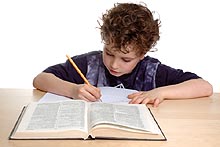| Magazine Home I Links I Contact Us |
|
Home |
Handwriting Problems
Handwriting is the most obvious feature of "the second R," and is a means to an end. Students who can write legibly and with reasonable speed are not deterred by weak handwriting skills from expressing themselves. Thus it is obvious that handwriting should become routine as rapidly and efficiently as possible. It should not be stressed at the expense of more important skills, such as those necessary to speak, listen, read, spell, or compose well. What is a Handwriting Problem? A handwriting problem exists when a student writes illegibly or extremely slowly. Everyone occasionally produces some illegible letters, but some students do so frequently enough that understanding what they have written is difficult; at this point, the difficulty would be considered a problem. Also, most children write quite slowly when they are first learning to print or write in cursive; slow handwriting should be considered a problem, however, when a student's writing speed interfered with his or her other work. Problems with handwriting are also known as dysgraphia, a term coined from the Greek words dys meaning ill or difficult and graphein meaning to write, and is used to describe a severe problem with handwriting. Synonyms for dysgraphia include motor agraphia, developmental motor agraphia, special writing disability, specific handwriting disability, specific learning disability in handwriting. Problems Related to Handwriting Though IQ is not related to handwriting, spelling apparently is, according to Introduction to Learning Disabilities by Hallahan et al. Students with poor handwriting are likely to have poor spelling skills. Two ways in which handwriting may contribute to misspellings are:
The first problem is one of legibility and the second is one of speed. Handwriting skill is also related to some perceptual and perceptual-motor skills. Wedell found that young students with handwriting problems had greater difficulties with position in space, drew poorly when drawing required crossing from one side of their bodies to the other, and did not benefit from handwriting tasks as much as other students. In her book Learning Disabilities: Theories, Diagnosis, and Teaching Strategies, Janet Lerner states that some of the underlying shortcomings that interfere with handwriting performance are (1.) poor motor skills, (2) faulty visual perception of letters and words, and (3.) difficulty in retaining visual impressions. The student's problem may also be in cross-modal transfer from the visual to motor modalities.
|
| Home A B C D E F G H I J K L M N O P Q R S T U V W X Y Z |